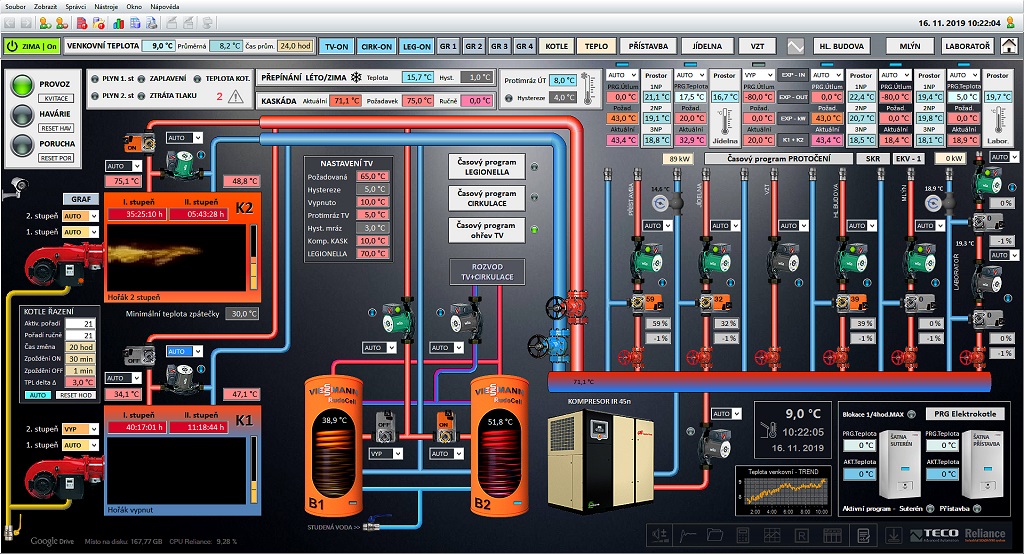Spending a regular day at Key, one will definitely hear words like PLC, SCADA and HMI being thrown around. And unless you regularly work within this discipline, these words may not make much sense to you. This blog aims to provide an insight into process control engineering, what a process control engineer does and some of the components regularly used in this discipline.
Let’s start with Process Control Engineering and what a process control engineer does.
Process control engineering is an engineering discipline that focuses on the design, implementation and maintenance of control systems within various industrial processes. These control systems utilise instrumentation to monitor and control certain parameters of a process such as temperature, pressure, flow rate etc.
Whilst an important aspect of a process control engineer’s role is to design, monitor and maintain control systems, the primary goal is to optimise the performance of any given process and ensure that it operates within safe and efficient limits.
Process control engineers regularly work with engineers and technicians from other engineering disciplines to ensure that the control system meets the requirements of the process.
We’ll now take a deeper look at two of the main components involved in process control engineering.
PLC (Programmable Logic Controller)
One of the components we deal with daily is a PLC, however not all disciplines of engineering and technology have had the chance to get a deeper understanding of what a PLC is.
A Programmable Logic Controller, or PLC, is a type of computer-based industrial control system that is commonly used to control and monitor industrial processes. They are designed to be rugged and reliable and can be programmed to perform a wide range of tasks, from simple on-off control to complex control algorithms.
PLCs are made up of several different components, including a central processing unit (CPU), input/output (I/O) modules and programming software. The CPU is the “brain” of the PLC and is responsible for executing the program that controls the process. I/O modules are used to connect the PLC to various sensors, actuators and other instrumentation in the process, such as temperature sensors, flow meters, and pumps. Lastly, the programming software is used to create and modify the program that is run by the PLC.
Below is an example of the various components on a modular PLC:
They have a wide range of industrial applications, such as manufacturing, power generation, water treatment, processing plants, mining processes and the oil and gas industry. PLCs are particularly well-suited for use in harsh environments thanks to their rugged and reliable design.
Benefits of a PLC include:
- Their flexibility: PLCs can be programmed to perform a wide range of tasks and can easily be reprogrammed to adapt to any changes in the process. This makes them ideal for use in applications where the process is constantly changing, such as a processing plant or an industrial manufacturing facility.
- Another benefit of PLCs is their ability to communicate with other systems. PLCs can be connected to other devices such as SCADA systems and HMIs allowing for real-time monitoring and control of the process. This can help to improve the efficiency and reliability of the process.
- PLCs can also be used to improve safety in industrial processes. They can be programmed to monitor for dangerous conditions and to shut down the process if necessary, reducing the risk of accidents.
We mentioned earlier about the programs that PLCs run to control and operate industrial processes.
What is PLC programming, one may ask?
PLCs must have a program created for them in order to carry out their designated tasks. These programs are typically created using programming devices or software. After the program is created, it is loaded into the PLC’s memory. The central processing unit (CPU) of the PLC uses the program to interpret input data and direct the PLC to perform the desired output actions. There are various programming languages that can be used to configure a PLC system however according to IEC 61131 (International Standard), there are 5 standard programming languages available:
- Ladder Logic or Ladder Diagram (LD)
- Function Block Diagram (FBD)
- Structured Text (ST)
- Sequential Function Chart (SFC)
- Instruction List (IL)
Ladder logic is the most commonly used programming language for PLCs. Its visual layout makes it easy to read and write, and it uses symbols to control relays, timers, shift registers, counters and perform mathematical operations. The symbols in the program are then translated and executed by the PLC system.
Here’s an example of a Ladder Diagram or Ladder Logic program:
SCADA (Supervisory Control and Data Acquisition) and HMI (Human Machine Interface)
Another term that will be heard at the engineering end of the Key offices is SCADA. SCADA stands for Supervisory Control and Data Acquisition. SCADA is a type of an industrial control system used together with PLCs to provide a graphical interface displaying the processes involved in any industrial systems. It allows for real time monitoring of industrial processes and infrastructure whilst also having the ability to control these systems depending on the level of control provided to it by design.
Benefits of SCADA systems:
- It’s ability to provide real-time monitoring helps operators, maintainers & engineers to detect and respond to any potential problems before they turn into major issues. This in turn assists with improving efficiency, reducing downtime and increasing safety within industrial processes.
- SCADA systems can also be used to collect and analyse large amounts of data, which can be used to improve the performance of industrial processes and infrastructure over time. This data can also be used to make more informed decisions about how to optimise and maintain industrial processes and plants.
Many engineers will also refer to another component that allows them to interact with plant machinery, HMI.
HMI stands for Human Machine Interface. It is typically a more simplistic graphical user interface (GUI) that can display process data, provide real-time information about the process and allow operators to control industrial equipment.
If you ever find yourself working in a process control engineering team or in an industrial facility, you will come across SCADA and HMI systems that use the ASM design standard.
What is the ASM standard?
The Abnormal Situation Management (ASM) standard is a set of guidelines and best practices for managing abnormal situations in industrial process control systems and used in SCADA and HMI systems. It was developed by the Centre for Chemical Process Safety (CCPS) and provides a framework for identifying, assessing and mitigating risks associated with abnormal situations. This includes procedures for detecting and responding to abnormal situations, as well as measures to prevent them from occurring in the first place.
The following design guidelines are followed when designing ASM Standard SCADA and HMI views:
- Bright intensity colours would be used for alarms and these colours won’t be used for anything else.
- Low intensity colours would be used for real-time data.
- The display background colour would be grey because it would have less interference with other colours.
- There would be less foreground colour and the colours which are used for alarms and real-time data won’t be used for other objects.
- There won’t be any gradient colours. Dark grey or black would be used for process lines.
- State depiction would be done by colours, text or by using shapes.
- The colour which is utilised would be standardised.
- In order to display important factors, shapes and colours are used together because certain colours could cause visual illusions when placed next to each other.
Benefits of using ASM standard SCADA/HMI over normal SCADA/HMI:
- Hazards and faults can be identified quickly.
- Improved human-machine interaction.
- Effective window management and layout.
- Easy navigation and better task view.
- Better reliability and safety.
- User-friendly graphical features.
Below are 2 examples of different types of SCADA pages that can be created for various processes:
And with that, we come to the end of this blog. I’d like to leave you with a thought; there are many every day situations as well where we would come across various forms of SCADA and HMI. With the information you now have, see if you can identify any 🙂
Thanks for taking the time to read this blog. I hope you find yourself equipped with some insights for when you next find yourself working with process control engineers.
Stay tuned to Key Blogs and our social media handles for more information and insights into the fascinating world of Process Control Engineering.




